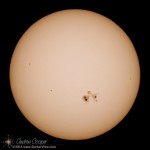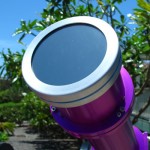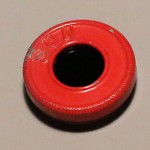You have heard it before, but it really is true! Looking at the Sun for longer than a few brief moments with an unprotected eye can lead to permanent damage. Looking at the Sun with any sort of optical deceive that has not been properly filtered can lead to instantaneous eye damage.
Discussed below are the only safe methods I am aware of to view the Sun. There are some dodgy methods out there. Take chance with your irreplaceable eyesight? I think not. Be careful and do it right if you want a look.
For the unaided eye there are a couple options to view the Sun safely…
Solar Viewing Glasses
Proper solar viewing filters are made from a thin plastic film, usually mylar, coated with metal to properly filter the Sun’s light for viewing with the unaided eye.
These are widely available and quite cheap. These offer a good view of the Sun for partial solar eclipses, transits, and the occasional sunspots large enough to see without magnification.
Do not attempt to use these viewers in conjunction with binoculars or small telescopes, they do not provide sufficient filtering for optics!
Welding Glass
Filters used for viewing welding offer much the same protection as solar filters. A shade 13 or darker welding filter can provide good protection for the unaided eye.
Again, do not use a welding filter with any sort of optical device such as binoculars, they are not designed for such use and may not block enough light.
Solar Filters for Telescopes
A much better view of some solar events can be seen if modest magnification is used. Do keep in mind that any sort of binoculars or telescope also concentrates much more light that the eye alone. Remember those childhood “experiments” involving a magnifying glass and ants? The best options here are the use of solar filters designed to be used on a telescope, or indirect means such as image projection.
Filters specifically designed for telescopes consist of either a plastic film, or a sheet of glass, coated with a thin layer of metal to block the Sun’s light. These filters pass about 1/1000 of one percent of the light.
More importantly, they block the harmful and unseen infrared and ultraviolet light that could so easily cause damage. The filters can be purchased in many sizes as appropriate for various models of telescopes, costing between one hundred and several hundred dollars.
Hydrogen Alpha Solar Telescopes
Some solar telescopes are designed to view the Sun in the light emitted by neutral hydrogen, a deep red light at 656mn.
In Hα light you may see solar flares and prominences as they produce enormous jets and arches of gas along the edge of the Sun.
These telescopes are quite expensive as the filters used are very precise, but they do offer a spectacular view of the Sun. Hα telescopes are usually purpose built telescopes usable for one task, looking at the Sun and the Sun only.
Image Projection
One of the simplest methods of displaying a solar image is projection. A white screen placed a foot or two behind a telescope will produce a very nice image of the Sun that can be safely viewed by a number of people simultaneously.
The method works best with small optical systems, binoculars or the smallest of telescopes. You do not need big optics to project a very nice solar image. Larger scopes will focus a great deal of energy into the beam, hundreds of watts, enough to damage telescope components near the focal point at the eyepiece.
Thus this method works best with telescopes of four inches (100mm) or less and most binoculars. Even with a small telescope keep in mind that the beam of light out of the eyepiece is quite intense, potentially hot enough to burn a careless finger placed near the exit from the telescope.
Pinhole Camera
You do not have any optics? Use the simplest optical arrangement of all, the pinhole camera! A pinhole camera is easily and cheaply constructed and provides a magnified image of the Sun that is better than looking at the Sun through solar viewing glasses or a welding filter.
Natural phenomena like the gaps in leaves often produce unintended pinhole cameras providing images of the Sun on the ground. In a deep partial eclipse one can see multiple little crescents underneath a tree. This can also happen inside where a small gap in a window shade produces an image of the Sun on the floor or wall.
What not to Use
There are a few things not to use… Dark sunglasses often do not filter the ultraviolet or infrared light that can be very damaging. The same goes for polarizing filters.
At one time solar filters meant to be screwed into the eyepiece were commonly sold with small telescopes. I recently came across such a unit in a kit of old telescope accessories.
Sitting near the focus of the telescope a great deal of light would be focused on the filter, heating the filter dramatically. This created the possibility of a catastrophic failure as the glass cracked from the heat. Proper solar filters are placed at the front of the telescope, at the entrance aperture where the light enters. This prevents excess light from entering the optics to begin with.
These eyepiece solar filters had nearly disappeared, but recently I have been seeing them on eBay and other import sites. Please do not use there and spread the word that they can be quite unsafe.
More Info
With so many safe ways to view the Sun there is no excuse not to be safe. If you are unsure of whether your solar equipment is safe do not use it. Your eyesight is far to valuable to risk. Let me repeat that… If you do not have a safe way of looking at the Sun do not look!
Following are a list of links to safe solar viewing equipment…
- Thousand Oaks filters for all models of telescope.
- Orion Telescopes filters from various suppliers for any telescope.
- Baader Solar Film, make your own solar filters for your telescope that can outperform some of the commercial filters. The film can be ordered from Baader or on Amazon and various telescope dealers.
- Rainbow Symphony markets a whole line of various solar glasses.
A few more references on safe solar viewing…
- Mr Eclipse Guide to Safe Solar Viewing a nice guide from Fred Espenak, an expert on Solar Eclipses
- Sky and Telescope magazine’s guide to solar viewing






